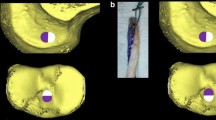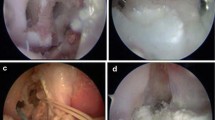Abstract
Many investigators have used animal models to clarify the role of the human anterior cruciate ligament (ACL). Because none of these models are anatomically and biomechanically identical to the human ACL, there exists a need for an objective comparison of these models. To do this, we used a universal force-moment sensor to measure and compare the in situ forces, including magnitude and direction, of the ACL and the anteromedial (AM) and posterolateral (PL) bundles of human, pig, goat, and sheep knees. An Instron was used to apply 50 and 100 N anterior tibial loads at 90° of knee flexion, while a universal force-moment sensor was used to measure the forces applied by the ACL to the tibia, the in situ force of the ACL. We found significant differences between the magnitude of force experienced by the goat and sheep ACL and AM and PL bundles when compared with the human ACL and AM and PL bundles. Also, the direction of the in situ force in the ACL and AM bundles of the goat and sheep were different from the human. The pig knee differed from the human only in the magnitude and direction of the in situ force in the PL bundle in response under anterior tibial loading. A tally of the significant differences between the animal models and the human knees indicates that goat and sheep knees may have limitations in modeling the human ACL, while the pig knee may be the preferred model for experimental studies.
Similar content being viewed by others
REFERENCES
Arnoczky, S. P., and J. L. Marshall. The cruciate ligaments of the canine stifle: An anatomical and functional analysis. Am. J. Vet. Res.38:1807-1814, 1977.
Ballock, R. T., S. L-Y. Woo, R. M. Lyon, J. M. Hollis, and W. H. Akeson. Use of patellar tendon autograft for anterior cruciate ligament reconstruction in the rabbit-A long term histological and biomechanical study. J. Orthop. Res.7:474- 485, 1989.
Barry, D., and A. M. Ahmed. Design and performance of a modified buckle transducer for the measurement of ligament tension. J. Biomech. Eng.108:149-152, 1986.
Berman, A. C. The goat model for prosthetic anterior cruciate ligament reconstruction. Trans. Soc. Biom.12:230, 1989.
Brandt, K. D., E. M. Braunstein, D. M. Visco, B. O'Connor, D. Heck, and M. Albrecht. Anterior (cranial) cruciate ligament transection in the dog: A bona fide model of osteoarthritis, not merely of cartilage injury and repair. J. Rheumatol.18:436-446, 1991.
Clancy, W. G. J., R. G. Narechania, T. D. Rosenberg, J. G. Gmeiner, D. D. Wisnefske, and T. A. Lange. Anterior and posterior cruciate ligament reconstruction in Rhesus monkeys: A histological, microangiographic, and biomechanical analysis. J. Bone Jt. Surg., Am. Vol.63(8):1270-1284, 1981.
Danychuck, K. D., J. B. Finlay, and J. P. Krcek. Microstructural organization of human and bovine cruciate ligament. Clin. Orthop. Rel. Res.131:294-298, 1978.
France, P. E., A. U. Daniels, M. E. Goble, and H. K. Dunn. Simultaneous quantitation of knee ligament force. J. Biomech.16:553-564, 1983.
Fujie, H., G. A. Livesay, S. Kashiwaguchi, G. Blomstrom, and S. L-Y. Woo. Determination of in situ force in the human anterior cruciate ligament: A new methodology. BED-22.22:91-94, 1992.
Fujie, H., G. A. Livesay, S. L-Y. Woo, S. Kashiwaguchi, and G. Blomstrom. The use of a universal force-moment sensor to determine in situ forces in ligaments: A new methodology. J. Biomech. Eng.117:1-7, 1995.
Fujie, H., K. Mabuchi, S. L-Y. Woo, G. A. Livesay, S. Arai, and Y. Tsukamoto. The use of robotics technology to study human joint kinematics: A new methodology. J. Biomech. Eng.115:211-217, 1993.
Fuss, F. K. Anatomy and function of the cruciate ligaments of the domestic pig: A comparison with human cruciates. J. Anat.178:11-20, 1991.
Guan, Y., D. L. Butler, S. G. Dormer, S. M. Feder, and M. Mayhan. Anterior cruciate subunit response during anterior drawer. In: ASME Biomechanics Symposium, Columbus, OH, 1991, pp. 201-204.
Gupta, B. N., K. N. Subramanian, W. O. Brinker, and A. N. Gupta. Tensile strength of canine cranial cruciate ligaments. Am. J. Vet. Res.32:183-190, 1971.
Holden, J. P., E. S. Grood, and J. F. Cummings. The effects of flexion angle and tibial rotation on measurement of anteromedial band force in the goat ACL. Trans. Orthop. Res. Soc.16:588, 1991.
Holden, J. P., E. S. Grood, D. L. Korvick, J. F. Cummings, D. L. Butler, and D. I. Bylski-Austrow. In vivoforces in the anterior cruciate ligament: Direct measurements during walking and trotting in a quadruped. J. Biomech.27:517-526, 1994.
Hollis, J. M. Development and application of a method for determining the in situ forces in anterior cruciate ligament bundles. Thesis, University of California, San Diego, 1988.
Hollis, M. J., J. P. Marcin, S. Horibe, and S. L-Y. Woo. Load determination in ACL fiber bundles under knee loading. Trans ORS13:58, 1988.
Hollis, M. J., S. Takai, D. J. Adams, S. Horibe, and S. L-Y. Woo. The effects of knee motion and external loading on the length of the anterior cruciate ligament: A kinematic study. J. Biomech. Eng.113:208-214, 1991.
Jasty, M., W. D. Lew, and J. L. Lewis. In vitro ligament forces in the normal knee using buckle transducers. Trans. Orthop. Res. Soc.7:241, 1982.
Johnson, R. A., and D. W. Wichern. Comparison of several multivariate means. In: Applied Multivariate Statistical Analysis. Englewood Cliffs, NJ: Prentice-Hall, 1988, pp. 210-272.
Korvick, D. L., G. J. Pijanowski, and D. J. Schaeffer. Three dimensional kinematics of the intact and cranial cruciate ligament-deficient stifle dog. J. Biomech.27:1, 77-87, 1993.
Lewis, J. L., M. Jasty, M. Schafer, and R. Wixson. Functional load directions for the two bands of the anterior cruciate ligament. Trans. Orthop. Res. Soc.5:307, 1980.
Lewis, J. L., W. D. Lew, J. A. Hill, K. J. Ohland, S. Kirkstukas, and R. E. Hunter. Knee joint motion and ligamental forces before and after ACL reconstruction. J. Biomech. Eng.111:97-106, 1989.
Lewis, J. L., W. D. Lew, and J. Schmidt. A note on the application and evaluation of the buckle transducer for knee ligament force measurement. J. Biomech. Eng.104:125-128, 1982.
Lewis, J. L., W. D. Lew, and J. Schmidt. Description and error evaluation of an in vitro knee joint testing system. J. Biomech. Eng.110:238-248, 1988.
Livesay, G. A., H. Fujie, S. Kashiwaguchi, D. A. Morrow, F. H. Fu, and S. L-Y. Woo. Determination of the in situ forces and force distribution within the human anterior cruciate ligament. Ann. Biomed. Eng.23:467-474, 1995.
Mendenhall, H. V. The goat as an animal model for anterior cruciate ligament research. In: Proceedings of the 2nd Annual Science Session of the Academy of Surgery Residence, 1986.
O'Donoghue, D. H., and C. C. Rockwod. Repair of the anterior cruciate ligament in dogs. J. Bone Jt. Surg., Am. Vol.48:503-519, 1966.
Oster, D. M., E. S. Grood, S. M. Feder, D. L. Butler, and M. S. Levy. Primary and coupled motions in the intact and the ACL deficient knee: an in vitro study in the goat model. J. Orthop. Res.10:476-484, 1992.
Parsons, F. The joints of mammals compared with those of man. Part II. Joints of the hind limb. J. Anat. Physiol.34:301-323, 1900.
Powers, D. L., P. A. Jacob, and M. J. Drews. Anatomical reconstruction of the anterior cruciate ligament in goats. J. Invest. Surg.4:191-202, 1991.
Shino, K., T. Kawasaki, H. Hirose, I. Gotoh, M. Inoue, and R. Ono. Reconstruction of the anterior cruciate ligament by allogenic tendon graft: An experimental study in the dog. J. Bone Jt. Surg., Brit. Vol.66:672-681, 1984.
Takai, S., G. A. Livesay, S. L-Y. Woo, D. J. Adams, and F. H. Fu. Determination of the in situ loads on the human anterior cruciate ligament. J. Orthop. Res.11:686-695, 1993.
Vilensky, J. A., B. L. O'Connor, K. D. Brandt, E. A. Dunn, P. I. Rogers, and C. A. DeLong. Serial kinematic analysis of the unstable knee after transection of the anterior cruciate ligament: Temporal and angular changes in a canine model of osteoarthritis. J. Orthop. Res.12:229-237, 1994.
Wascher, D. C., K. L. Markolf, M. S. Shapiro, and G. A. M. Finerman. Direct in vitro measurement of the forces in cruciate ligaments. Part I: The effect of multiplane loading of the intact knee. J. Bone Jt. Surg., Am. Vol.75:377-386, 1988.
Xerogeanes, J. W., Y. Takeda, G. A. Livesay, Y. Ishibashi, H. S. Kim, F. H. Fu, and S. L-Y. Woo. Effect of knee flexion on the in situ force distribution in the human anterior cruciate ligament. Knee Surg. Sports Traumatol. Arthrosc.3:9-13, 1995.
Author information
Authors and Affiliations
Rights and permissions
About this article
Cite this article
Xerogeanes, J.W., Fox, R.J., Takeda, Y. et al. A Functional Comparison of Animal Anterior Cruciate Ligament Models to the Human Anterior Cruciate Ligament. Annals of Biomedical Engineering 26, 345–352 (1998). https://doi.org/10.1114/1.91
Issue Date:
DOI: https://doi.org/10.1114/1.91




